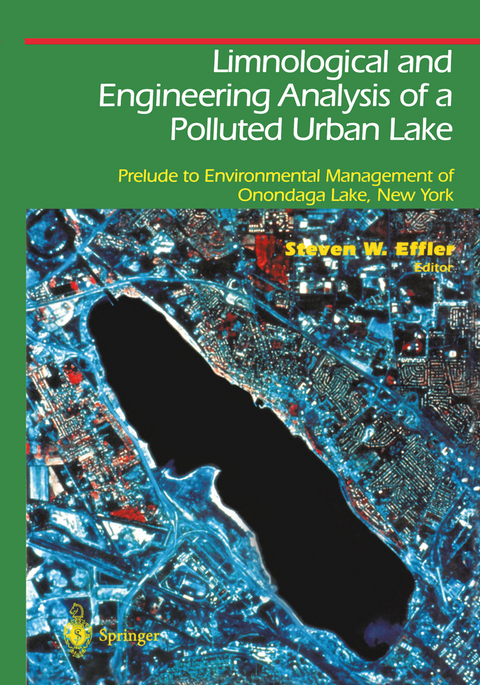
Limnological and Engineering Analysis of a Polluted Urban Lake
Springer-Verlag New York Inc.
978-1-4612-7500-8 (ISBN)
1. Background.- 1.1 Location and Morphometry.- 1.2 Tributaries and Subbasins.- 1.3 Climate.- 1.4 Historic Account.- 1.5 Specific Waste Sources.- 1.6 Technical Studies of Onondaga Lake and Its Tributaries.- 1.7 Demography and Land Use.- 1.8 Government Involvement and a Community´s Vision.- 1.9 Summary.- References.- 2. Hydrogeologic Setting.- 2.1 Background Geology.- 2.2 Geology and Hydrogeology of the Major Tributaries to Onondaga Lake.- 2.3 Special Topics Related to the Hydrogeology of Onondaga Lake.- 2.4 Onondaga Lake.- 2.5 Basic Concepts in Hydrogeology.- 2.6 Summary.- References.- 3. Tributaries and Discharges.- 3.1 Hydrology of Onondaga Lake.- 3.2 Material Loading.- 3.3 Summary.- References.- 4. Hydrodynamics and Transport.- 4.1 Introduction.- 4.2 Lake Inflows and Outflow.- 4.3 Lake Temperature, Salinity, and Density Stratification.- 4.4 Lake Circulation.- 4.5 Modeling Stratification and Vertical Transport...- 4.6 Horizontal Mass Transport Model.- 4.7 Summary.- References.- 5. Chemistry.- 5.1 Salinity.- 5.2 Dissolved Oxygen.- 5.3 Inorganic Carbon, Ca2+, CaCO3(S), and pH.- 5.4 Nitrogen Species.- 5.5 Phosphorus.- 5.6 Anoxic Organic Carbon Decomposition and the Distribution of Related Chemical Species.- 5.7 Mercury.- 5.8 Particle Chemistry.- 5.9 Summary.- References.- 6. Biology.- 6.1 Phytoplankton.- 6.2 Zooplankton.- 6.3 Aquatic Macrophytes.- 6.4 Benthic Macroinvertebrates.- 6.5 Fish Communities and Habitats in Onondaga Lake, Adjoining Portions of the Seneca River, and Lake Tributaries.- 6.6 Indicator Bacteria.- 6.7 Summary.- References.- 7. Optics.- 7.1 Introduction.- 7.2 Optical Measurements.- 7.3 Optical Properties of Water.- 7.4 Historic Changes in Apparent Optical Properties.- 7.5 Components of Attenuation /Evaluation of Empirical Relationships.- 7.6 RegionalComparison.- 7.7 Angular Distribution of Underwater Irradiance...- 7.8 Checks on Optical Measurements and Estimates.- 7.9 Estimates of a and b.- 7.10 Spectroradiometer Measurements.- 7.11 Partitioning a.- 7.12 Partitioning b.- 7.13 Components of Attenuation, Models, and Analysis of Scenarios.- 7.14 Summary.- References.- 8. Sediments.- 8.1 Deposition.- 8.2 Surficial Sediments.- 8.3 Sediment Stratigraphy.- 8.4 Summary.- References.- 9. Mechanistic Modeling of Water Quality in Onondaga Lake.- 9.1 Background and Evolution of Model Frameworks.- 9.2 Chloride Model.- 9.3 Total Phosphorus Model.- 9.4 Nitrogen Model.- 9.5 Dissolved Oxygen Model.- 9.6 Fecal Coliform Bacteria Model.- 9.7 Water Quality Model for the Seneca and Oswego Rivers.- 9.8 Application of Models.- 9.9 Summary.- References.- 10. Synthesis and Perspectives.- 10.1 Impact of the Soda Ash/Chlor-alkali Facility on Onondaga Lake and Adjoining Systems: Update.- 10.2 The Polluted State of Onondaga Lake: How Bad Is It?.- 10.3 But Has Not the Quality of Onondaga Lake Improved?.- 10.4 The METRO Discharge Is Too Much for a Small Lake.- 10.5 Diversion of METRO.- 10.6 Where Do We Go from Here?.- References.
| Reihe/Serie | Springer Series on Environmental Management |
|---|---|
| Zusatzinfo | 832 p. |
| Verlagsort | New York, NY |
| Sprache | englisch |
| Maße | 178 x 254 mm |
| Themenwelt | Naturwissenschaften ► Biologie ► Ökologie / Naturschutz |
| Technik ► Elektrotechnik / Energietechnik | |
| Technik ► Umwelttechnik / Biotechnologie | |
| Schlagworte | Onondaga Lake |
| ISBN-10 | 1-4612-7500-8 / 1461275008 |
| ISBN-13 | 978-1-4612-7500-8 / 9781461275008 |
| Zustand | Neuware |
| Haben Sie eine Frage zum Produkt? |
aus dem Bereich


